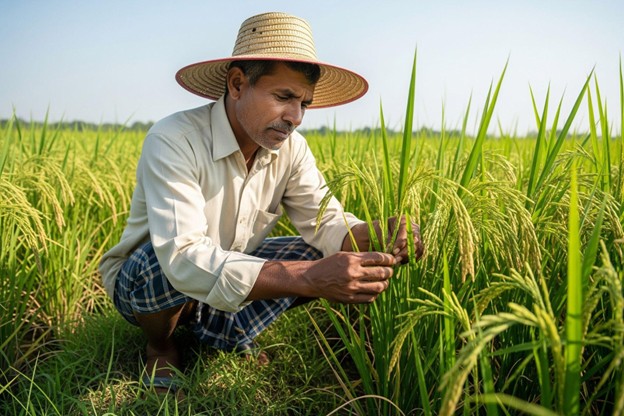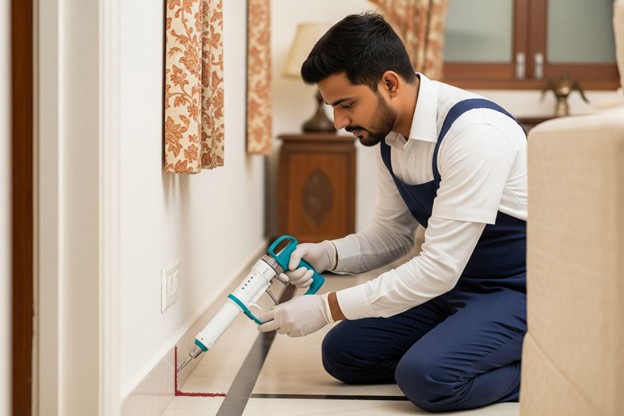What Is Integrated Pest Management (IPM) and Why Does It Matter in India

Published :05 Aug 2025

Pest control in India is no longer just about spraying chemicals and hoping for the best. With growing concerns around health, food safety, environmental damage, and pesticide resistance, there's a clear need for a smarter and more sustainable approach. That’s where Integrated Pest Management (IPM) comes in—a method focused on controlling pests in harmony with nature, not fighting it.
In a country like India, where agriculture is vital, cities are densely packed, and pest-borne diseases are rising, IPM is not just a trend—it’s a necessity. Whether you're a farmer or a homeowner, understanding IPM can help reduce risks and improve long-term outcomes.
For practical implementation, professional support from eco-conscious providers can make a big difference.
So, what is IPM, and why does it matter so much in India? Let’s dive in.
Understanding Integrated Pest Management (IPM)
Integrated Pest Management (IPM) is a sustainable approach to pest control that emphasizes balance over elimination. Rather than relying solely on chemicals, IPM combines observation, prevention, and targeted action to manage pests at safe levels while protecting the environment.
By asking key questions—like the pest's type, life stage, and natural predators—IPM tailors solutions to specific conditions. In a diverse country like India, this makes it especially effective, adapting to everything from rural farms to urban gardens.
Whether you're dealing with mosquitoes on a balcony or borers in a crop field, IPM is smart, eco-friendly, and flexible—suited for homes, offices, and agriculture alike.
Key Principles of IPM: The Foundation
IPM follows a systematic and science-based process. Here are the main pillars:
1. Prevention First
The first step in IPM is preventing pests from becoming a problem in the first place. In farming, this might mean crop rotation, soil health improvement, or selecting pest-resistant crop varieties. In homes, it means sealing entry points, reducing moisture, and cleanliness.
2. Monitoring and Identification
IPM stresses the importance of regular monitoring. Farmers are trained to scout their fields for early signs of pest activity. Similarly, in urban spaces, pest control professionals assess infestation levels before recommending action.
3. Setting Action Thresholds
Rather than spraying at the first sign of trouble, IPM uses action thresholds—a point at which pest damage becomes economically significant. This helps prevent overuse of pesticides and ensures treatments are necessary.
4. Multiple Control Methods
IPM doesn't rely on a single solution. Instead, it uses a combination of methods, starting with the least harmful and moving up as needed—only applying pesticides as a last resort.
Why IPM Matters in Indian Agriculture
Agriculture in India supports over 50% of the population. But pests are a major threat, destroying 15%–25% of total crop yield annually, according to ICAR (Indian Council of Agricultural Research).
IPM Offers a Sustainable Solution for Farmers
- Reduces Dependency on Pesticides: Farmers often overuse chemical pesticides, leading to soil degradation, water contamination, and health risks. IPM encourages safer alternatives.
- Improves Yield Quality: Healthier crops mean better market prices and safer food for consumers.
- Protects Beneficial Insects: IPM supports biodiversity, allowing pollinators and natural predators to thrive.
- Reduces Costs: Though initial training may be needed, IPM practices help reduce long-term input costs.
Success stories like Sikkim's organic farming initiatives and IPM projects in Punjab's rice fields prove that with proper training and community involvement, IPM works in India's complex agricultural landscape.
IPM in Urban India: Not Just for Farms

Urban areas face rising pest issues—from cockroaches in kitchens to mosquitoes in stagnant water. Integrated Pest Management (IPM) offers a safer, long-term solution without overusing chemicals.
Apartments and offices can adopt IPM through routine inspections, sanitation, and eco-friendly treatments like gel baits and biological larvicides. Simple steps like fixing leaks, sealing cracks, using window mesh, and keeping garbage areas dry go a long way.
Even homeowners can contribute with natural repellents and preventive care. For severe cases, professional pest control services trained in IPM offer safe, effective solutions tailored for city living.
Environmental and Health Benefits of IPM
India has already paid a heavy price for pesticide misuse—from poisoned rivers and pesticide-linked farmer suicides to pesticide residues in vegetables. IPM offers a clean break.
Here's how IPM makes a difference:
- Less Chemical Exposure: Fewer toxic sprays means reduced health risks for children, pets, and workers.
- Protects Soil and Water: Prevents chemical buildup in the environment.
- Supports Biodiversity: Encourages natural pest predators like birds, ladybugs, and frogs.
- Safer Food: Especially important for organic food producers and health-conscious consumers.
By focusing on ecology rather than eradication, IPM promotes harmony between humans and the environment.
Challenges to IPM Adoption in India
Despite its benefits, IPM isn't mainstream in India yet. Why?
Barriers Include:
- Lack of Awareness: Many farmers and residents are unaware of IPM's advantages.
- Limited Access to Resources: Rural areas often lack access to training or biological control agents.
- Policy Gaps: Government schemes supporting IPM exist but lack funding and grassroots implementation.
- Cultural Mindset: Many believe chemical sprays = instant results, even if it's temporary and toxic.
To overcome these, India needs more education, demonstration farms, and community IPM programs.
IPM vs. Traditional Pest Control
Let's do a quick comparison:
| Feature | Traditional Control | Integrated Pest Management (IPM) |
|---|---|---|
| Focus | Pest elimination | Pest management |
| Methods | Chemical-heavy | Combination of natural + chemical |
| Environmental Impact | High | Low |
| Long-Term Effectiveness | Low (pest resistance) | High (systemic control) |
| Cost | Lower upfront, higher long-term | Slightly higher upfront, cost-effective over time |
IPM is clearly the more sustainable and health-conscious choice, especially for a country like India with both rural and urban pest challenges.
Real Case Studies: IPM in Action Across India
Explore the real-world impact of Integrated Pest Management (IPM) across India—where IPM not only reduced pest damage but also mitigated insecticide resistance, lowered disease transmission in urban areas, enhanced environmental health, and improved agricultural yields in both rural and city-based communities.
Pune Slum Community Intervention
A field-based study conducted in an urban slum area of Pune (Pashan region), using the Health Belief Model framework, involved community education and preventive practices against dengue vectors. Despite low baseline knowledge—only 26.1% residents identified mosquito breeding spots indoors—trained community volunteers conducted awareness sessions, household inspections, and environmental clean-ups.
This intervention significantly improved residents' understanding of mosquito behavior and led to concrete action. As a result, the house index (the percentage of homes with mosquito breeding sites) dropped dramatically—indicating that simple IPM tactics like identifying breeding spots, removing stagnant water containers, and educating residents can transform an urban neighborhood.
Delhi Non-Transmission Surveillance Program
In Delhi's high-risk dengue zones, a pilot by the National Institute of Malaria Research (NIMR) and South Delhi Municipal Corporation implemented year-round surveillance and larval control during non-monsoon months. In 20 neighborhoods under this programme, regular inspections, community messaging, and container-based interventions achieved:
- A 63% drop in container index (CI)
- A 62% reduction in house index (HI)
- No reported dengue cases in the study zone—while nearby control areas saw multiple cases
Sikkim's Organic Transition with Indigenous Pest Practices
Between 2003 and 2016, Sikkim transformed into India's first fully organic state, banning synthetic pesticides and relying on traditional pest control and IPM practices. Farmers adopted biopesticides, crop rotation, neem sprays, and mechanical weeding. A study documenting indigenous practices in the Sikkim Himalayan region emphasized the role of traditional knowledge, including ash, salt, and botanical extracts, in pest management—laying the groundwork for effective IPM in organic agriculture.
Cotton IPM Success Against Pink Bollworm in Maharashtra
ICAR-NCIPM implemented a cotton IPM validation project in Maharashtra's Khandwa and Jalna districts, promoting techniques for pink bollworm control. Results included a 49% reduction in insecticide sprays, higher yield in IPM fields (19.50 q / ha vs. 17.33 q / ha), and increased populations of beneficial insects like spiders and lacewings—demonstrating resistance management without sacrificing productivity.
Meanwhile, Project Bandhan in Vidarbha introduced the PBKnot pheromone-based mating disruption technology across 300+ acres. This method significantly reduced pink bollworm infestation, avoids harming beneficial insects, and aligns with IPM's eco-friendly ethos.
Resistance Management in Punjab's Long-Term IRM Programme
Punjab's multi-year resistance management programme (2002–13) focused on rationalizing pesticide use in Bt cotton fields. Farmers trained under IRM protocols used fewer insecticide applications while maintaining yields. A longitudinal study (2004–2016) showed more than 15% fewer insecticide applications and no yield loss compared to non-IRM farmers. This highlights IPM's ability to sustainably manage resistance over time.
Conclusion
India's pest challenges—be it in farms or cities—require more than temporary fixes. Integrated Pest Management (IPM) offers a proven, practical, and eco-friendly solution that balances pest control with health, safety, and sustainability.
Whether you're a farmer growing crops or a parent protecting your child from dengue, IPM matters. It's not just about fewer pests—it's about a better quality of life for every Indian.
As awareness grows, embracing IPM can lead to healthier ecosystems, more resilient agriculture, and safer living spaces. It's a shift in mindset—from reaction to prevention, from chemical dependency to intelligent control. The future of pest management in India lies in this balanced, informed, and sustainable approach.
FAQs
Cultural, mechanical/physical, biological, and chemical controls—used in combination based on need.
IPM is strategic and sustainable, using chemicals only when necessary, while traditional pest control often relies solely on pesticide sprays.
Yes. While training and tools may have a small upfront cost, IPM saves money over time by reducing crop loss and pesticide dependency.
Absolutely. IPM principles apply in residential settings for controlling mosquitoes, cockroaches, termites, and rodents using safe, multi-step strategies.
Look for pest control companies that emphasize eco-friendly practices, offer customized treatment plans, and avoid blanket spraying.